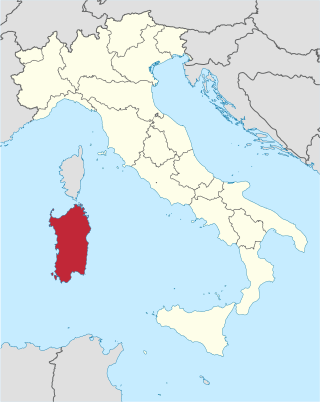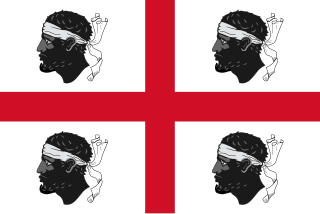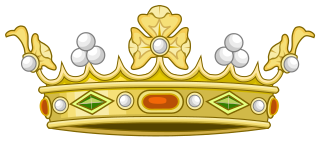Related Research Articles

Sardinian or Sard is a Romance language spoken by the Sardinians on the Western Mediterranean island of Sardinia.

Sardinia is the second-largest island in the Mediterranean Sea, after Sicily, and one of the twenty regions of Italy. It is located west of the Italian Peninsula, north of Tunisia and immediately south of the French island of Corsica.

Bertoleoni is the proclaimed ruling family of the styled "Kingdom of Tavolara", which claimed to be "the smallest kingdom of the world". The members of this family were also the only inhabitants of this island that had been abandoned in 1962. The island was claimed by Italy, however, it was never officially annexed and therefore this does not abolish any prior royal titles. The people of the island sustained themselves by goat farming and fishing. Currently, the supposed kingdom is a tourist attraction for the 57 or so native inhabitants of the island, where the current king and crown princess run its two restaurants and sell souvenirs to visitors of the Natural Park. The family has more influence over the island than anyone else.

Giovanni Maria Angioy was a Sardinian politician and patriot and is considered to be a national hero by Sardinian nationalists. Although best known for his political activities, Angioy was a university lecturer, a judge for the Reale Udienza, an entrepreneur and a banker.

The Kingdom of Sardinia, also referred to as the Kingdom ofSardinia-Piedmont or Piedmont-Sardinia as a composite state during the Savoyard period, was a country in Southern Europe from the late 13th until the mid-19th century.

The Sardinians, or Sards, are a Romance language-speaking ethnic group native to Sardinia, from which the western Mediterranean island and autonomous region of Italy derives its name.

Vicente Bacallar y Sanna, 1st Marquess of San Felipe, later italianized into Vincenzo Bacallar Sanna, 6 February 1669 – The Hague (Netherlands), 11 June 1726). He was a Sardinian nobleman, military officer, linguist, historian, politician and ambassador of the Spanish Empire. He was born to a noble Sardinian family when the kingdom of Sardinia was part of the Spanish crown.

Marquess of San Felipe, was a hereditary title in the Peerage of Spain and Peerage of Sardinia, granted in 1709 by Philip V to Vicente Bacallar y Sanna, a Sardinian historian of Valencian origin who served as ambassador in the Spanish Netherlands and the Republic of Genoa

Sardinian nationalism or also Sardism is a social, cultural and political movement in Sardinia calling for the self-determination of the Sardinian people in a context of national devolution, further autonomy in Italy, or even outright independence from the latter. It also promotes the protection of the island's environment and the preservation of its cultural heritage.
This article presents a history of Cagliari, an Italian municipality and the capital city of the island of Sardinia. The city has been continuously inhabited since at least the neo-lithic period. Due to its strategic location in the Mediterranean and natural harbor, the city was prized and highly sought after by a number of Mediterranean empires and cultures.
Marquis of Neoneli is a title granted in 1774 by Victor Amadeus III of Savoy, king of Sardinia, to Sardinian nobleman Pedro Ripoll. It has passed afterwards to the house Sanjust.
Marquis of San Sperate is a title granted in 1749 by Charles Emmanuel III of Savoy, king of Sardinia, to Sardinian judge and nobleman Joseph Cadello. It has passed afterwards to the house Ripoll and eventually to Sanjusts.
Marquis of Montemuros, also called Monte Muros, is a title granted in 1762 by Charles Emmanuel III of Savoy, king of Sardinia, to Sardinian nobleman and lord Pedro Martinez. It got extinguished in 1918.
Marquess of Soleminis is a title granted in 1651 by Philip IV, king of Spain and king of Sardinia, to the Sardinian nobleman Francisco Angel Vico Sonza. It has passed afterwards to the house Amat.
Marquis of St. Charles is a title granted in 1754 by Charles Emmanuel III of Savoy, king of Sardinia, to Sardinian feudal Lord James Borro. It has passed afterwards to the house Palici and eventually to Cugias.

The House of Malaspina was a noble Italian family of Longobard origin that descended from Boniface I, through the Obertenghi line, that ruled Lunigiana from the 13th to the 14th centuries, and the marquisate of Massa and lordship of Carrara since the 14th century.

The Sardinia national football team is the official football team of Sardinia. It is organised by the Sardinian National Sports Federation, founded in 2012. The team has been colloquially referred with the name Sa Natzionale.
Duke of Vallombrosa was a title created for the House of Manca. The present holder is disputed.

Sardinian surnames are surnames with origins from the Sardinian language or a long, identifiable tradition on the Western Mediterranean island of Sardinia.
References
- ↑ E. Vacca Odone, p. 445.
- ↑ Ordinamento dello stato nobiliare italiano (Statute of the Italian nobility status), art. 5.
- ↑ See the genealogical tree.
- ↑ See the Mancas' genealogical tree.